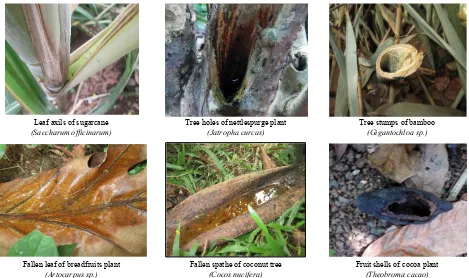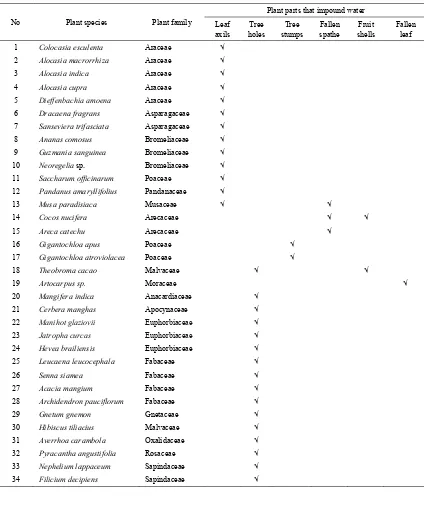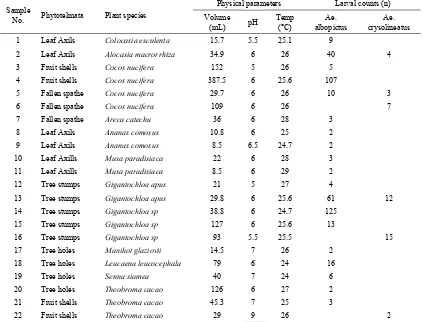Phytotelmata Might Account for the High Prevalence of
Dengue Hemorrhagic Fever in Lampung, Indonesia
Emantis Rosa, Mohammad Kanedi*, Putri Minggar Okatviani, Welmi Nopia Ningsih
Departmen of Biology, Faculty of Mathematics and Sciences, Lampung University, Indonesia
Abstract
It was revealed that phytotelmata is an importance breeding place for numerous types of insect including the vector mosquitoes of deadly diseases such as dengue and malaria. Yet, such small ponds tend to be neglected by the country health authorities in setting eradication program of the disease vectors. This study aimed to find out whether phytotelmata contribute in providing breeding place for vector mosquito of dengue hemorrhagic fever (DHF)- the Ades larvae. The survey carried out in four districts namely Pesawaran, Metro, Pringsewu and Bandar Lampung and lasted from March to August 2016. Phytotelmic criteria of the study were every structures present in plants which allow rain water to impound and showed the signs of life exist in it. The phytotelmata containing Aedes mosquito larvae were assessed for its physical parameters and the data resulted were analysed and presented descriptively. There were six types of phytotelmata found namely leaf axils, tree holes, tree stumps, fallen spathe, fruit shells, and fallen leaves. The Aedes larvae found belong to only two species, i.e.Aedes albopictus (n=373) and Aedes crysolineatus (n=26).
Keywords
Phytotelmata, Mosquito breeding place, Dengue fever, Aedes larvae, Vector mosquito1. Introduction
Dengue hemorrhagic fever (DHF) is one of the mosquito-borne diseases that is prevalent in the Indonesian provinces, including Lampung. It said prevalent due to the occurrence of the disease is seasonal in pattern and often be an outbreak in a certain area. In the period of 2000-2012, in the province of Lampung with a population of about 8 million, more than 14,174 people suffered from DHF and 151 of them died [1, 2].
Despite the government, both national and local, have been implementing a variety of strategies to eradicate the diseases, among others, through the eradication of the vector but in fact, this disease still occur annually. The question, then, why is it so hard to prevent the disease, especially in relation to vector control? As is known, most Indonesian people have been briefed by the authorities for vector control programs against deadly diseases such as dengue and malaria through the insertion of these materials into primary and secondary school curricula. In the context of DHF, one of the most information known to the community is that this disease is transmitted by the mosquito Aedes aegypti [3].
One of the shortcomings of vector control programs in use today, particularly against mosquitoes, is ignoring that the breeding places of the vectors are not just limited to the
* Corresponding author:
[email protected] (Mohammad Kanedi) Published online at http://journal.sapub.org/als
Copyright © 2017 Scientific & Academic Publishing. All Rights Reserved
ponds, water container, or a variety of man-made waste items such as discarded tyres or used cans. In fact, various species of vector mosquitoes such as Aedes sp. were found to breed in a very small water bodies trapped in tree holes, leaf axils, bamboo joints, or papaya stumps [4, 5]. Such small water bodies found in or upon plants are called, by Ludwig Varga in 1928, as phytotelmata [6]. Unfortunately, in Indonesia, study on phytotelmata has not been done in earnest [7]. As a result, the importance of phytotelmata in the epidemiological fields and health management programs has not been put into consideration.
This study aimed to find out whether phytotelmata contribute in providing breeding place for mosquito vector of DHF in Lampung, an Indonesian province situated in the most southern part of Sumatra, by identifying mosquito larvae of Aedes inhabit the phytotelmata.
2. Method
Study Area
for the DHF incident rate in 2012 [8].
Inclusion Criteria
The phytotelmic criteria of the study was adopted from Kicthing [6] i.e. every structures present in terrestrial plants such as modified leaves, leaf axils, flowers, stem holes or depressions, tree stumps, open fruits and fallen leaves, which allow rain water to impound and in the impounded water the signs of life was seen visually. Plants that were observed include ornamental plants grown in backyard, wild plants and crop plants that grown naturally or cultivated in plantation areas.
Sampling
Each plant or its parts found to contained phytotelmata was photographed or sampled for further taxonomic identification. The impounded water in each phytotelmata was collected using a hose connected to a manual suction pump, but before being discharged the phytotelmic water temperature was measured. The phytotelmic fluid then placed separately in labeled vials and transported to the laboratory for further analysis. At the laboratory, the mosquito larvae were sorted and separated from trash and other debris. Then, the volume and pH of the phytotelmic water were assessed. The dead larvae were separated from the living larvae and put into bottles containing 70% alcohol for toxonomic identifiaction. Furthermore, the living larvae were kept alive and reared until reachs mature stage. Both the dead and living larvae of the mosquitoes were examined under a stereo microscope Nikon Olympus SZ51. The taxonomic procedures for larval identification and determination of genus Aedes referring to the work of Farajollahi and Price [9].
Data Analysis
The data resulted from the study were presented and analysed using descriptive statistics.
3. Results
There were five types phytotelmata found in the study namely leaf axils, tree holes, fallen spathe, fallen leaves, and open fruit shells (Fig. 1). Plant species the complete list of plant species with parts that fulfil the inclusion criteria as phytotelmata found in the study are presented in Table 1. Of all the phytotelmic sample, 22 of them were found to contain larvae of Aedes mosquito. The larval count of the Aedes mosquitoes and the physical parameters of the phytotelmic water are presented in Table 2.
The data in Table 2 can be elaborated as follows. There are two species of Aedes mosquito larvae managed to be identified in this study, i.e. Ae.albopictus and
Ae.crysolineatus. The larvae can be found in the phytotelmata with a volume as low as of 8.5 ml, i.e. in the leaf axils of pineapple (Ananas comosus) and banana (Musa paradisiaca). In average, a single larvae of Ae. albopictus
can even live in the water column with a volume of only 0.31 ml, such as in the hole of bamboo stumps where 125 larvae inhabit water column with a volume of 38.8 ml. Phytotelmic water temperature that can be occupied by Aedes larvae is ranged from 24 to 29°C, but seemingly the most preferred temperature is 24-26°C (Fig. 2). Phytotelmic water pH range where Aedes larvae are found is 5.5 - 9, with the most preferred pH by both species is 6 (Fig. 3).
Leaf axils of sugarcane (Saccharum officinarum)
Tree holes of nettlespurge plant (Jatropha curcas)
Tree stumps of bamboo (Gigantochloa sp.)
Fallen leaf of breadfruits plant (Artocarpus sp.)
Fallen spathe of coconut tree (Cocos nucifera)
Fruit shells of cocoa plant (Theobroma cacao)
Table 1. The plant species and plant parts that impound water serves as phytotelmata in Lampung
No Plant species Plant family
Plant parts that impound water
Leaf axils
Tree holes
Tree stumps
Fallen spathe
Fruit shells
Fallen leaf
1 Colocasia esculenta Araceae √
2 Alocasia macrorrhiza Araceae √
3 Alocasia indica Araceae √
4 Alocasia cupra Araceae √
5 Dieffenbachia amoena Araceae √
6 Dracaena fragrans Asparagaceae √
7 Sanseviera trifasciata Asparagaceae √
8 Ananas comosus Bromeliaceae √
9 Guzmania sanguinea Bromeliaceae √
10 Neoregelia sp. Bromeliaceae √
11 Saccharum officinarum Poaceae √
12 Pandanus amaryllifolius Pandanaceae √
13 Musa paradisiaca Musaceae √ √
14 Cocos nucifera Arecaceae √ √
15 Areca catechu Arecaceae √
16 Gigantochloa apus Poaceae √
17 Gigantochloa atroviolacea Poaceae √
18 Theobroma cacao Malvaceae √ √
19 Artocarpus sp. Moraceae √
20 Mangifera indica Anacardiaceae √
21 Cerbera manghas Apocynaceae √
22 Manihot glaziovii Euphorbiaceae √
23 Jatropha curcas Euphorbiaceae √
24 Hevea brailiensis Euphorbiaceae √
25 Leucaena leucocephala Fabaceae √
26 Senna siamea Fabaceae √
27 Acacia mangium Fabaceae √
28 Archidendron pauciflorum Fabaceae √
29 Gnetum gnemon Gnetaceae √
30 Hibiscus tiliacius Malvaceae √
31 Averrhoa carambola Oxalidaceae √
32 Pyracantha angustifolia Rosaceae √
33 Nephelium lappaceum Sapindaceae √
34 Filicium decipiens Sapindaceae √
Figure 3. Range of phytotelmic water pH found inhabited and preferred by Ae albopictus (A) and Ae crysolineatus (B)
Table 2. The physical parameters of phytotelmata in which Aedes mosquito larvae are found
Sample
No. Phytotelmata Plant species
Physical parameters Larval counts (n)
Volume
(mL) pH
Temp (°C)
Ae. albopictus
Ae. crysolineatus
1 Leaf Axils Colocasia esculenta 15.7 5.5 25.1 9
2 Leaf Axils Alocasia macrorrhiza 34.9 6 26 40 4
3 Fruit shells Cocos nucifera 152 5 26 5
4 Fruit shells Cocos nucifera 387.5 6 25.6 107
5 Fallen spathe Cocos nucifera 29.7 6 26 10 3
6 Fallen spathe Cocos nucifera 109 6 26 7
7 Fallen spathe Areca catechu 36 6 28 3
8 Leaf Axils Ananas comosus 10.8 6 25 2
9 Leaf Axils Ananas comosus 8.5 6.5 24.7 2
10 Leaf Axills Musa paradisiaca 22 6 28 3
11 Leaf Axills Musa paradisiaca 8.5 6 29 2
12 Tree stumps Gigantochloa apus 21 5 27 4
13 Tree stumps Gigantochloa apus 29.8 6 25.6 61 12
14 Tree stumps Gigantochloa sp 38.8 6 24.7 125
15 Tree stumps Gigantochloa sp 127 6 25.6 13
16 Tree stumps Gigantochloa sp 93 5.5 25.5 15
17 Tree holes Manihot glaziovii 14.5 7 26 2
18 Tree holes Leucaena leucocephala 79 6 24 16
19 Tree holes Senna siamea 40 7 24 6
20 Tree holes Theobroma cacao 126 6 27 2
21 Fruit shells Theobroma cacao 45.3 7 25 3
22 Fruit shells Theobroma cacao 29 9 26 2
4. Discussion
This research was conducted in 2016, the year in which 4.523 people in the studied province found suffered from DHF and 15 of them were died. In the surveyed district namely Pesawaran, Metro, Pringsewu and Bandar Lampung, the DHF patients consecutively were 324 (one died), 222 (two died), 684 (three died) and 826 (one died) [10]. This study has confirmed the findings of previous studies that in nature, mosquito larvae, including the larvae of Culex spp. [11],Ochlerotatus notoscriptus [12] and Ae albopictus can breed in various small water bodies including the dried
fallen leaves and tree holes [13]. Interestingly, besides
Ae. albopictus and Ae. crysolineatus, this study did not find any Ae. aegypti mosquito larvae in each phytotelmata that was investigated. The question is why?
The first possibility is Ae aegypti mosquito prefers to breed indoor in a small water body such as in the open masonry tanks used for water storage, or out door in a small water body trapped in the discarded goods such as old tyres and cans [14, 15].
albopictus, commonly called as the Asian tiger mosquito, is known as a secondary vector of dengue [16]. In Indonesia alone, precisely in Banjarnegara, Central Java, the role of Ae albopictus in dengue disease transmission is indicated by Rahayu and Ustiawan [17]. Of course, it should be recognized that the morphological appearance of both species is very resemble to each other. A strong evidence that
Ae albopictus can contribute to the spread of dengue demonstrated by Rosa et al. [18]. By using RT-PCR methods for detecting dengue viruses on Ae.albopictus larvae inhabit phytotelmata they found two serotypes of dengue viruses DEN-1 and DEN-4 and suggested that the mosquito has the potential to transmit and spread DHF.
The third possibility which account for Ae.aegypti are not found in phytotelmata is the larvae allegedly did not manage to compete with Ae. albopictus larvae. As shown by a study carried out in Malaysia, Ae.aegypti has lower competitive advantage compared to Ae.albopictus in situation of limited resources. This situation allegedly the cause of the dominancy of Ae. albopictus mosquito in Penang Island [19]. The high adaptability of Ae albopictus is illustrated by the extent of the spread of mosquitoes that originally indigenous to South-east Asia and islands of the Western Pacific and Indian Ocean, to Africa, the mid-east Europe and the Americas (north and south) [20, 21].
Lastly, the conditions that may lead to the absence of Ae aegypti in the phytotelmata samples found in this study are the difference of physical condition suitable for the larvae. As revealed from an experimental study, the best water temperature for the Ae aegypti mosquito larvae to grow is 30°C [22], while the temperature of the phytotelmic water in where the larvae of Ae albopictus found in this study is 24 - 29°C.
5. Conclusions
This research was conducted in the year in which the incidence rate of DHF was high, however the study did not manage to find Ae aegypti in addition to Ae albopictus and Ae crysolineatus. Given Ae albopictus was revealed to contain viruses DEN 1 and DEN 4, and has been long known as a secondary vector of dengue fever, then it can be assumed that Ae albopictus could potentially be the DHF vector and phytotelmata might account for the high prevalence of the disease in Lampung, Indonesia.
REFERENCES
[1] Kemenkes RI. 2014. Profil Kesehatan Indonesia Tahun 2013 (Indonesia Health Profile 2013, Publised by Ministry of Health of Republic of Indonesia 2014).
http://www.depkes.go.id/resources/download/pusdatin/profil -kesehatan-indonesia/profil-kesehatan-indonesia-2013.pdf. [2] Dinkes Lampung. 2015. Profil Kesehatan Provinsi Lampung
Tahun 2015 (Provincial Health Profile of Lampung 2014, publised by Lampung Provincial Health Office 2015). http://dinkes.lampungprov.go.id/profil-kesehatan-provinsi-la mpung-tahun-2014/.
[3] Ditjen PP&PL Kemenkes. 2011. Modul Pengendalian Demam Berdarah Dengue. (Handouts of DHF control). http://www.pppl.depkes.go.id/_asset/_download/manajemen %20DBD_all.pdf.
[4] Chadee D. D., Ward R.A. and Novak R.J. 1998. Natural Habitats of Aedes Aegypti in The Caribbean a Review. Journal of the American Mosquito Control Association, 14(l): 5-11, 1998.
[5] Ali K.M., Asha A.V. and Aneesh E.M. Bioecology and Vectorial Capacity of Aedes mosquitoes (Diptera: Culicidae) in Irinjalakuda Municipality, Kerala, India in Relation to Disease Transmission. Int. J. Curr. Res. Aca. Rev. 2014; 2(4): 43-49.
[6] Kitching, R.L. 1971. An Ecological Study of Water-Filled Tree-holes and Their Postion in the Woodlad Ecosystem. Journal of Animal Ecology 40 (2): 281-302.
[7] Rosa E, Dahelmi, Salmah S. and Syamsuardi, 2014. Fluctuation of Diptera Larvae in Phytotelmata and Relation with Climate Variation in West Sumatra Indonesia. Pakistan Journal of Biological Sciences, 17: 947-951.
[8] Dinkes Lampung. 2014. Profil Kesehatan Lampung 2013 (Provincial Health Profile of Lampung 2013, publised by Lampung Provincial Health Office 2014).
http://www.depkes.go.id/resources/download/profil/Profil_K es_Provinsi_2013/08_Prov_Lampung_2013.pdf.
[9] Farajollahi A. and Price D.C. 2013. A Rapid Identification Guide for Larvae of the Most Common North American Container-Inhabiting Aedes Species of Medical Importance. Journal of the American Mosquito Control Association, 29(3): 203–221, 2013.
[10] Malik A.S. 2017. “4.523 Warga Lampung Terserang DBD Sepanjang 2016”: A Press Release from Public Relation of Lampung Provincial Health Office. Lampost.co, Friday, 13 Januari 2017. http://lampost.co/berita/4.523-warga-lampung-terserang-dbd-sepanjang-2016-2017.
[11] Campost R.E. and Lounibos L.P. 1999. Eryngium Spp (Umbelliferae) as Phytotelmata and Their Culex (Culex) Inhabitants in Temperate Argentina. Journal of the American Mosquito Control Association, 15(4):493-499, 1999. [12] Derraik, J.G.B., 2005. Mosquitoes breeding in phytotelmata
in native forests in the Wellington region, New Zealand. New Zealand J. Ecol., 29: 185-191.
[13] Simard F., Nchoutpouen E., Toto J.C. and Fontenille D. 2005. Geographic Distribution and Breeding Site Preference of
Aedes albopictus and Aedes aegypti (Diptera: Culicidae) in Cameroon, Central Africa. J. Med. Entomol. 42(5): 726Ð731 (2005).
[14] Philbert A. and Ijumba J.N. 2013. Preferred breeding habitats of Aedes Aegypti (Diptera-Culicidae) Mosquito and its public health implications in Dares Salaam, Tanzania. E3 Journal of Environmental Research and Management Vol. 4(10). pp. 0344-0351, November, 2013.
(Linnaeus) in the City of Kolkata, India, Following an Outbreak of Dengue during 2012. Current Urban Studies, 2,
57-61.
[16] Benedict M.Q., Levine R.S. Hawley W.A. and Lounibos L.P. 2007. Spread of the Tiger: Global Risk of Invasion by the Mosquito Aedes albopictus. Vector Borne Zoonotic Dis. 2007; 7(1): 76–85.
[17] Rahayu D.F. and Ustiawan A. 2013. Identifikasi Aedes aegypti dan Aedes albopictus. BALABA 9 (01), Juni 2013: 7-10.
[18] Rosa, E., Dahelmi., Salmah, S., & Syamsuardi. (2015). Detection of Transovarial Dengue Virus with RT-PCR in Aedes albopictus (Skuse) Larvae Inhabiting Phytotelmata in Endemic DHF Areas in West Sumatra, Indonesia. American Journal of Infectious Diseases and Microbiology, 3(1), 14-17.
[19] Khim P.C. 2007. Bionomics of Aedes Aegypti and Aedes Albopictus in Relation to Dengue Incidence on Penang Island and the Application of Sequential Sampling in the Control of Dengue Vectors. Thesis submitted in fulfilment of the requirements for the degree of Master of Science. Universiti Sains Malaysia: 190 P.
[20] Gratz N.G. 2004. Critical review of the vector status of Aedes albopictus. Med Vet Entomol. 2004 Sep; 18(3): 215-27. [21] Laxmikant S. 2014. Distribution of Aedes aegypti and Aedes
albopictus from Jalna District (MS) India. Bioscience Discovery, 5(1): 11-14, Jan. 2014.


